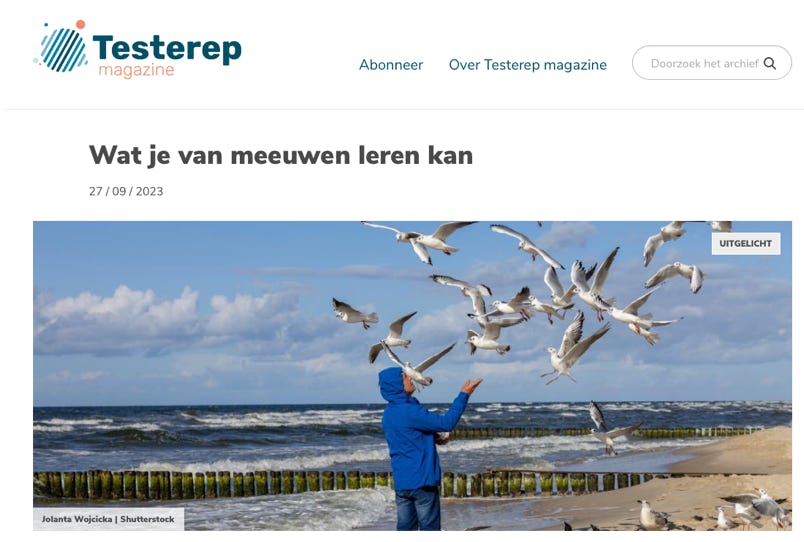27/09/2023
Luc and Frederick sat down with Testerep, the digital magazine of the Flanders Marine Institute (VLIZ), for an in-depth conversation on gulls. In the full interview, available in Dutch on VLIZ’s website, they share insights on gull cognition and behavior. Here, we've translated and highlighted a few compelling excerpts for our English-speaking readers (Translated with DeepL.com)
“Birds are stupid, people used to think. That the bird brain does not have the right structures and organisation to develop any thinking or learning ability at all. Meanwhile, science recognises that not only humans and great apes, but also birds, octopuses and a lot of other species are good at learning and problem-solving. ‘We urgently need to investigate that further!’, thought cognitive psychologist Frederick Verbruggen and bird researcher Luc Lens. Gulls turn out to be a very interesting object of study in this respect. And all the more so because gulls appear to differ greatly individually, both in terms of learning ability and personality. Do better learning ability, an impulsive or rather calculated character guarantee a greater chance of survival in gulls? Testerep magazine spoke to the researchers.
- NANCY FOCKEDEY”
Research on gulls and their personality
Prof Frederick Verbruggen (UGent) is a cognitive psychologist by training. He therefore studies how the brain processes knowledge (attention, memory, consciousness, emotions, language, action control). He previously did extensive research on how people can control and modify their own behaviour, and what role learning plays in this. In the distant past, psychologists conducted tests with animals to better understand learning behaviour in humans. That type of research had kind of fallen into oblivion. ‘I recently restarted working with animals in psychology at UGent. But rather to study the psychology of the animals themselves, and to find out how they learn and adapt their behaviour to a changing environment.’
From the very beginning, Frederick received the support of Prof. Luc Lens, ecologist and bird researcher, also at UGent (TEREC). Luc has been studying gull behaviour and migration in the field for quite some time. To distinguish them from each other individually, the gulls are given a ‘personal’ colour ring on the leg, or - more recently - a tracker on the back, which follows their comings and goings (LifeWatch Tracking Network). Looking at that data, he saw that each gull behaves differently. ‘Individuals of the same species each appear to have a distinct personality. It interested me to explore this further. And to see how that character can drive gull survival, selection and evolution.
A new research field with lots of angles
‘Setting up experiments to study animal behaviour in captivity is not simple. Frederick's expertise was therefore very welcome,’ Luc states. The two researchers quickly found each other. Together with An Martel of the Faculty of Veterinary Medicine, they set to work. Thanks to long-term research funding from the Methusalem project, they formed a now 15-strong interdisciplinary team studying learning behaviour in birds. This research programme aims to understand nothing less than the learning and thinking capacity of animals. How do individual differences arise when processing information? And what if you apply this to domains such as inhibition or behavioural flexibility? By the way, they do not only work with gulls. Chickens, quails, pigeons, canaries, etc. are also in the spotlight. In turn, An Martel studies what gulls eat in the wild, and how good or bad this is for their brain development.
The research results will not only allow them to better explain selection and evolution (theoretical ecology). In the future, they also hope to be able to actively use the results around information processing to improve animal welfare in farms, or to make reintroduction programmes more successful. And from these new insights, perhaps bird sanctuaries can also learn something.
Bird sanctuary as breeding school for experiments with gulls
Gulls are just handy for this type of behavioural research because you can breed them in captivity. The Seagull Team on the coast sometimes receives requests after complaints by residents to remove gull eggs from nests on roofs. The Ostend Bird Rescue Centre then incubates the eggs, with the intention of releasing the young afterwards. After all, seagulls are both wild and protected animals. Before then, some of these chicks are - for a while at least - Frederick and Luc's guinea pigs or rather ‘guinea gulls’.
Frederick Verbruggen: ‘When the gull chicks are about three weeks old, you can carry out experiments with them to study their learning and thinking abilities, personality or temperament. Then we release them into the wild with a transmitter on their back, and follow them up throughout their lives. This way, we can find out whether their personality and cognition have any influence on their survival success. Gulls live long lives, easily 20-30 years anyway. They also often breed in the same place year after year. Which makes it easier to monitor them for a long time.’
Challenges and opportunities in tracking
Luc Lens: ‘The next challenge is to see how we can extract data on cognition from the tracking data itself. Every year we transmit 60 gulls. When the gulls die, the GPS transmitters continue to work. We can locate their dead bodies and find out the cause of death. In 50%, a fox is the culprit. We are now finding out whether we can also infer this predation from the transmitter data profile, and whether we can link it to their cognition. Do certain specimens handle acquired cognition differently, making them more vulnerable to predators? The specimens that perish from predation often turn out to be inexperienced or sick animals.’ Frederick Verbruggen: ‘We are now also looking at how young animals react when a (stuffed) fox suddenly appears in a cage, and how different their reactions are. One of our gulls attacked this fox and even started pecking at its head and teeth. So it will be interesting what that same gull will do next in its life when it meets a real fox.’
